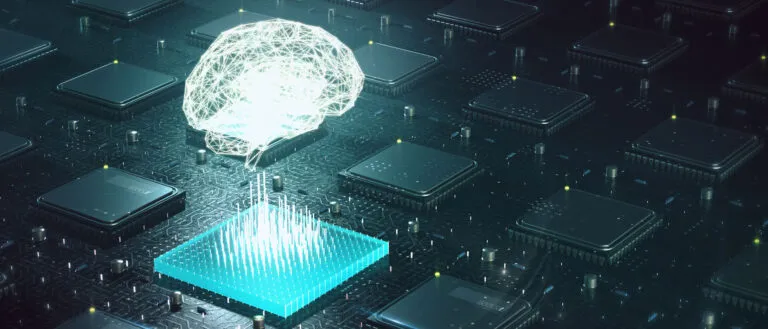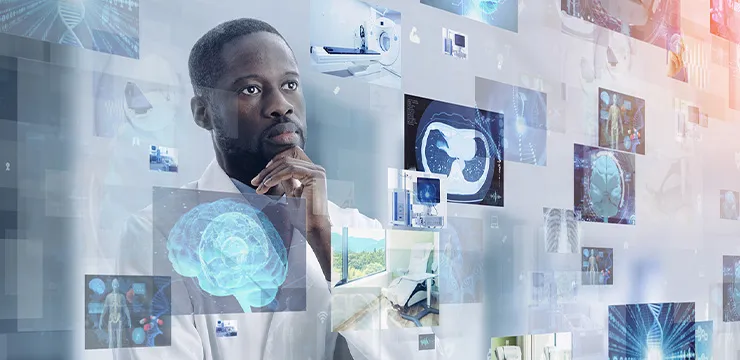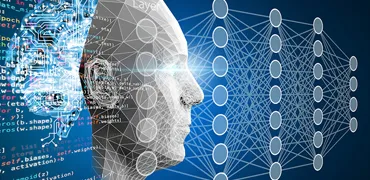What is Deep Learning: Everything You Need to Know

- What is Deep Learning, and How Does it Differ From Machine Learning?
- What are the Different Types of Deep Learning Algorithms?
- Can You Provide Real-Life Examples of Deep Learning Applications?
- What are the Career Opportunities in the Field of Deep Learning?
- How Can One Get Started in a Career in Deep Learning?
Deep learning, a subset of artificial intelligence, has revolutionized how machines learn and make decisions. Understanding what is deep learning is crucial for anyone looking to navigate the complex landscape of modern technology. This article aims to demystify the field for a diverse audience who seek to leverage deep learning in their professions. The objective, therefore, is for readers to gain a comprehensive insight into this transformative technology. We explore its definitions, differences from traditional machine learning, types, real-world applications, and opportunities in deep learning careers.
What is Deep Learning, and How Does it Differ From Machine Learning?

Deep learning, a branch of artificial intelligence, uses multilayered neural networks—hence the term “deep”. These networks aim to mimic human thought and learning processes, allowing machines to handle data in a complex and intuitive way. Trainers teach deep learning models using large sets of labeled data and neural network architectures that directly learn features from the data, eliminating the need for manual feature extraction.
One of the key strengths of deep learning is its ability to make sense of unstructured data such as images, sound, and text. Consequently, industries that deal with massive amounts of data have significantly benefited from deep learning technologies, as they can automate tasks that require interpreting complex data sets.
How Deep Learning Differs From Machine Learning (ML)
Deep learning and machine learning are both integral components of artificial intelligence, yet they differ significantly in various aspects of their application and operation. This section explores these differences in depth across multiple dimensions, highlighting what is deep learning and how it operates as a specialized subset of machine learning.
| Criteria | Machine Learning (ML) | Deep Learning (DL) |
| Relationship | Encompasses a range of algorithms for interpreting data | A subset of ML, deep learning utilizes layered neural networks for deeper data analysis |
| Data Representation | Relies on structured data such as tables and arrays | Processes unstructured data, such as images and text, via neural networks |
| Data Scale | Effective on smaller or medium-sized data sets | Requires larger data sets for optimum function |
| Output Types | Generates predictions or classifications | Capable of generating various outputs, including new content from learned inputs |
| Algorithm Setup | Requires analysts to structure data and variables | Once trained, it adapts automatically to incoming data |
| Training Time | Takes less time due to simpler data needs | Requires extended training periods for large data sets |
| Feature Engineering | Needs explicit programming for feature extraction | Automates feature extraction directly from data |
| System Complexity | Generally less complex and requires less computational power | More complex architectures, requiring substantial power |
| Current Applications | Common in traditional sectors such as finance and health care | Drives cutting-edge applications like autonomous driving |
| Accuracy and Resources | Highly effective but needs optimization for complex tasks | Greater accuracy in complex data interpretation but requires more resources |
ALSO READ: What is a Neural Network? Why are its Applications Important?
What are the Different Types of Deep Learning Algorithms?
1. Convolutional Neural Networks (CNNs)
To understand what is deep learning, it is essential to learn about the different types of deep learning algorithms. Convolutional Neural Networks (CNNs) are a cornerstone of deep learning, particularly adept at processing data arranged in grids, most commonly images. In essence, CNNs leverage a mathematical operation called convolution. To elaborate, convolution involves a filter that slides across the input data, generating a feature map. This feature map captures the presence and intensity of specific features within the data. Consequently, CNNs excel at tasks like image classification, facial recognition, and any other application where identifying patterns is crucial.
2. Recurrent Neural Networks (RNNs)
Recurrent Neural Networks (RNNs) specifically handle sequential data, such as time series or language. What sets RNNs apart is their unique ability to retain information in their hidden state. Interestingly, this information is then passed from one step in the sequence to the next. This inherent memory allows RNNs to excel at tasks where context and continuity are essential, such as speech recognition or text generation. However, despite their strengths, RNNs can be susceptible to problems like vanishing gradients. To address these limitations, developers created newer architectures such as LSTMs and Gated Recurrent Units (GRUs).
3. Long Short-Term Memory Networks (LSTMs)
Long Short-Term Memory networks (LSTMs) can be viewed as an evolution of the basic RNN, specifically designed to capture long-term dependencies within sequence data. Unlike RNNs, LSTMs don’t have vanishing or exploding gradient problems. LSTMs achieve this through a complex architecture that incorporates gates, which regulate the flow of information within the network. These networks are vital for tasks where there are significant gaps between important information, such as complex language models or sequential prediction problems.
4. Generative Adversarial Networks (GANs)
Generative Adversarial Networks (GANs) are a fascinating concept that involves two neural networks locked in competition: a generator and a discriminator. The generator’s role is to create data, while the discriminator works to evaluate it. This competitive setup allows GANs to generate synthetic data of exceptional quality, often indistinguishable from real data. Consequently, they are widely used in image generation, video creation, and even in the synthesis of human-like text.
5. Autoencoders
Autoencoders are a type of unsupervised learning model. Their objective is to learn a compressed, encoded representation of data sets. This compressed representation is typically used for dimensionality reduction or feature extraction purposes. The network essentially learns to compress the data into a coded format and then attempts to reconstruct the output to closely match the original input. This ability makes them particularly useful in tasks like anomaly detection or noise reduction.
ALSO READ: What is the Relevance of Named Entity Recognition in NLP?
6. Restricted Boltzmann Machines (RBMs)
Restricted Boltzmann Machines (RBMs) are a unique type of neural network that falls under the category of stochastic neural networks. They have the capability to learn a probability distribution over their set of inputs. This allows them to identify the underlying probability distribution of a data set. RBMs are often employed in recommendation systems, feature learning, and deep belief networks, as they excel at modeling complex, nonlinear relationships within data.
7. Deep Belief Networks (DBNs)
Deep Belief Networks (DBNs) are generative models composed of multiple layers of stochastic, latent variables. These latent variables are essentially hidden and not directly observable. The bottom layers of a DBN form a directed acyclic graph, while the top layers form an undirected associative memory. DBNs are known for their ability to extract deep features from data, making them a valuable tool for tasks like image recognition, video recognition, and motion capture.
8. Self-Organizing Maps (SOMs)
A type of unsupervised learning model, SOMs produce a two-dimensional, discretized representation of the input space of training samples. They are particularly useful for visualizing complex data with many variables. By simplifying the data and revealing underlying patterns, SOMs can provide valuable insights for further analysis.
9. Sequence-to-Sequence Models
Such models are designed for a specific purpose: converting sequences from one domain to another. These models consist of two main components—an encoder that processes the input sequence and a decoder that generates the output sequence. Sequence-to-sequence models are pivotal in understanding what is deep learning, especially tasks like machine translation, speech recognition, and text summarization, where the input and output sequences can vary in length.
10. Deep Reinforcement Learning
Deep reinforcement learning combines the principles of reinforcement learning with deep neural networks. This marriage of techniques allows systems developed with deep reinforcement learning to learn and achieve complex goals or strategies. These capabilities are crucial in dynamic environments such as gaming, autonomous vehicles, and robotics, where traditional approaches might struggle.
ALSO READ: Understanding the Inner Workings of Autoencoders in Deep Learning
Can You Provide Real-Life Examples of Deep Learning Applications?
 1. Image Recognition
1. Image Recognition
One of the cornerstone applications of deep learning is image recognition, which involves training computers to interpret and understand the visual world. Essentially, the answer to the question “what is deep learning” is that deep learning empowers computers to analyze and extract meaning from digital images and videos. Using deep neural networks, particularly Convolutional Neural Networks (CNNs), these systems can identify objects, faces, and scenes with high accuracy. Image recognition technology is integral in various fields. For instance, security surveillance it can automatically identify potential threats in real time, enhancing public safety. In the retail industry, image recognition can improve customer experience through interactive kiosks that can recognize products and provide information or recommendations.
2. Speech Recognition
Deep learning has revolutionized speech recognition systems, significantly improving their accuracy. These systems are one of the most important deep learning examples powered by Recurrent Neural Networks (RNNs) and Long Short-Term Memory networks (LSTMs), and can now understand and transcribe spoken language into text with remarkable precision. This capability has led to a wide range of applications. For example, speech recognition is used in real-time voice translation devices, allowing seamless communication across languages. Virtual assistant technologies like Siri and Alexa, leverage speech recognition, to understand user requests and provide assistance. In the customer service industry, speech recognition can be used to route calls based on the customer’s verbal request, streamlining the process and improving customer satisfaction.
3. Natural Language Processing (NLP)
Natural Language Processing (NLP) applications are another form of deep learning examples that leverage deep learning to bridge the gap between human language and computers. In essence, NLP allows computers to interpret, generate, and understand human language in a way that is valuable for businesses. This field encompasses a variety of applications, including chatbots that can provide customer support, sentiment analysis tools that gauge public opinion from social media data to understand customer sentiment, and language translation services that enable communication across different languages. Furthermore, NLP is vital in creating more engaging and personalized user experiences across various software applications and online platforms.
4. Autonomous Vehicles
Deep learning types or models play a critical role in the development of autonomous vehicles. These models are responsible for processing and interpreting the vast amount of data collected from vehicle sensors and cameras, including LiDAR, radar, and traditional cameras. By analyzing this data in real time, deep learning models enable autonomous vehicles to make informed navigation decisions, such as obstacle detection, lane following, and traffic light recognition. Consequently, deep learning helps in improving the safety and efficiency of autonomous driving systems, a key technology that will revolutionize the future of transportation.
5. Health-Care Diagnostics
In health care, deep learning algorithms are transforming diagnostics and treatment processes. These algorithms can perform a variety of tasks, such as analyzing medical images like X-rays, MRIs, and CT scans to detect abnormalities and aid in disease diagnosis. Additionally, deep learning models can be used to predict patient outcomes based on medical history and other relevant data, allowing for more personalized treatment plans. Moreover, deep learning is being explored in drug discovery processes to identify potential drug candidates more quickly and cost-effectively than traditional methods.
ALSO READ: Exploring the Revolution: How the CNN Neural Network is Shaping the Future of AI
6. Personalized Recommendations
Deep learning powers recommendation systems that are ubiquitous in e-commerce platforms like Amazon and media streaming services like Netflix. By analyzing vast amounts of user behavior data, such as purchase history, browsing activity, and watch history, these systems can suggest products or content that the user is more likely to enjoy. This personalization enhances user satisfaction and engagement, leading to increased sales and business customer loyalty.
7. Fraud Detection
The financial sector heavily relies on deep learning for fraud detection and prevention. Deep learning systems analyze transaction patterns to identify unusual behaviors that might indicate fraudulent activities, such as unauthorized access or suspicious purchases. By flagging these anomalies in real time, deep learning helps protect both financial institutions and their customers from potential losses.
8. Robotics
Deep learning is facilitating advanced automation in the field of robotics. Robots equipped with various deep learning types and algorithms can perform complex tasks with greater precision and adaptability. For instance, robots in warehouses can use deep learning for object recognition and manipulation, enabling them to pick and pack items efficiently. In surgical settings, robots powered by deep learning can assist surgeons with delicate procedures, improving accuracy and minimizing human error. Additionally, understanding what is deep learning allows you to know how robots learn from each interaction with their environment, enabling them to become more efficient and effective over time.
9. Predictive Maintenance
Manufacturing industries are benefiting from deep learning applications in predictive maintenance. By analyzing data from sensors embedded in equipment, deep learning models can predict potential failures before they occur. This proactive approach allows for scheduled preventative maintenance, avoiding costly downtimes and extending the lifespan of machinery. Predictive maintenance powered by deep learning can significantly improve operational efficiency and reduce costs for manufacturers.
10. Content Generation
Deep learning is even being used for creative content generation. Deep learning models like Generative Adversarial Networks (GANs) can be trained to generate artistic images, write stories, or compose music. This technology is particularly impactful in the creative industries, providing artists and designers with tools that inspire new forms of artistic expression. For example, deep learning can be used to generate variations on existing artwork, create photorealistic images from sketches, or even compose music in different styles. This opens doors for innovative collaborations between humans and AI, where human creativity can be amplified by the capabilities of deep learning models.
ALSO READ: Mastering Deep Learning: The 10 Must-Know Algorithms for AI Professionals in 2024
What are the Career Opportunities in the Field of Deep Learning?
1. Data Scientist
Data scientists who specialize in deep learning leverage their skills to analyze large sets of data and derive insights using advanced algorithms. Moreover, they play a critical role in predictive modeling and decision-making processes across sectors, thus helping organizations to make data-driven decisions. Additionally, these professionals often work in teams to integrate data findings into operational processes, thus improving efficiency.
2. Machine Learning Engineer
Machine learning engineers focus on designing and implementing machine learning applications, including those based on deep learning models. Furthermore, these professionals ensure that the algorithms perform as expected on large-scale systems, thus playing a pivotal role in the development and deployment of AI solutions. Moreover, they continuously test and refine models based on real-world data, ensuring high accuracy and reliability of ML applications.
3. Research Scientist
These professionals are at the forefront of advancing the underlying technologies and discovering new methods and techniques in artificial intelligence to provide more insight into what is deep learning. Consequently, they publish their findings, contribute to academic knowledge, and often collaborate with other experts in the field. Also, research scientists push the boundaries of what deep learning can achieve, exploring innovative ways to apply it across different domains.
4. Deep Learning Architect
They design the overall structure of AI systems, focusing on creating scalable and efficient deep learning models that can be integrated into various applications. Moreover, deep learning architects ensure that the architectural choices support both the immediate requirements and the long-term vision of AI projects, thus playing a crucial role in bridging the gap between model development and practical implementation. Additionally, they work closely with stakeholders to understand their needs and tailor solutions accordingly.
5. Algorithm Engineer
Algorithm engineers specialize in creating efficient algorithms that solve complex problems using deep learning. Thus, their work is critical in optimizing the performance of AI systems, ensuring that they are both effective and scalable. Furthermore, these engineers often develop new algorithms that can significantly improve the speed and accuracy of deep learning models, making them more accessible and usable in real-world applications.
6. Computer Vision Engineer
They apply deep learning to interpret and understand visual information from the world. Moreover, their work is essential in areas such as autonomous driving, robotic navigation, and security systems, where visual data plays a critical role. They also design and implement systems that can accurately detect and classify objects, enhancing the capabilities of machines to interact with their environments.
7. NLP Scientist
NLP scientists use what deep learning to develop systems that understand human language in a way that is both meaningful and contextually appropriate is. As a result, their expertise is vital in creating more intuitive user interfaces and improving human-computer interaction. These scientists work on complex problems such as sentiment analysis, language translation, and speech recognition, pushing the envelope in how machines understand and respond to human language.
8. Business Intelligence Developer
Business intelligence developers utilize deep learning to transform data into actionable intelligence. Their skills help organizations optimize their operations, enhance strategic decision-making, and gain competitive advantages. Moreover, by implementing deep learning models, they can uncover patterns and predictions that are not visible through traditional data analysis techniques.
9. Robotics Engineer
Robotics engineers incorporate deep learning into the design and functioning of robots, thus enabling these machines to perform tasks that require adaptive and intelligent behavior. Their work is pivotal in industries like manufacturing, health care, and logistics. Additionally, these engineers have the skills to enhance the autonomy of robots, allowing for more complex tasks to be performed with greater precision and efficiency.
10. Software Developer (AI/ML Focus)
Software developers with a focus on AI and ML integrate what is deep learning into software applications, enhancing their functionality and user experience. In fact, these professionals bridge the gap between advanced AI technologies and practical software solutions that meet user needs. Additionally, they often collaborate with data scientists and machine learning engineers to ensure that the applications they develop are powered by the most effective and efficient AI algorithms available.
Through these roles, professionals in the field of deep learning contribute significantly to technological advancements and innovation. Moreover, to truly understand what is deep learning is to know that it will continue to evolve and expand. As such, the demand for skilled individuals in these roles is expected to grow, underscoring the importance and excitement of pursuing a career in this dynamic field.
ALSO READ: How AI is Fundamentally Changing the Nature of Search
How Can One Get Started in a Career in Deep Learning?
 1. Educational Paths
1. Educational Paths
Most deep learning positions require at least a Bachelor’s degree in Computer Science, Data Science, or a related field where they get a nuanced understanding of what is deep learning. Moreover, pursuing a master’s or a diploma course can be particularly beneficial, as deeper specialization in topics like neural networks, machine learning, and computational statistics is often required. Educational institutions often provide specialized tracks that focus specifically on deep learning as well. This can greatly enhance both theoretical knowledge and practical skills.
2. Online Courses
Online platforms offer a wealth of courses that cover fundamental and advanced topics in understanding what is deep learning. These courses often include hands-on projects and case studies, which are crucial for developing a real-world understanding of how deep learning can be applied across various industries.
3. Boot Camps
For those looking to skill up, or learn what is deep learning quickly, boot camps offer intensive, hands-on training in AI and machine learning, including specific modules on deep learning. Boot camps are designed to be immersive, allowing you to learn and apply new skills in a condensed timeframe, which is beneficial for those aiming to transition quickly into the field.
4. Certifications
Obtaining certifications from recognized industry bodies or technology companies can help validate your skills to employers. Additionally, certifications in specific tools such as TensorFlow, PyTorch, or Keras are highly regarded in the field. These certifications often require passing a rigorous exam that tests your knowledge of what is deep learning and your ability to implement deep learning models effectively.
5. Internships
Gaining real-world experience through internships is invaluable. They also provide networking opportunities and insights into the AI industry, thus helping to set a strong foundation for a career in what is deep learning. Additionally, internships allow professionals to work on practical problems, also offering the chance to contribute to potentially important projects.
ALSO READ: What is NLP? How Machines Learn to Understand Us
6. Networking
Attending industry conferences, seminars, and workshops can help one connect with other professionals and stay up-to-date with the latest advancements in deep learning. Additionally, participating in forums and online communities can also be beneficial. These networking opportunities can lead to collaborations, job offers, insights into future trends, and a more intensive understanding of what is deep learning.
7. Portfolio Development
Building a portfolio of projects that showcase deep learning skills can be crucial. Projects demonstrate the ability to apply deep learning to real-world problems, an important criterion for potential employers. In fact, a well-curated portfolio can serve as a tangible demonstration of your skills and understanding of what is deep learning.
8. Entry-Level Jobs
Starting in entry-level roles related to data analysis, software development, or support in AI projects can lead to more specialized positions in deep learning as one gains experience and furthers their education about what is deep learning. Moreover, these positions provide practical experience about the various challenges and requirements of working in the AI industry.
9. Industry Conferences
Participating in or even presenting at conferences can enhance knowledge and reputation in the field. These events are also excellent for networking and learning from leading experts.
10. Continuous Learning
The field of deep learning is continually evolving, making ongoing learning essential. Furthermore, staying current with new tools, techniques, and research ensures professionals remain competitive and effective in their careers.
ALSO READ: 10 Popular AI Applications in Real Life: A Comprehensive Guide
From this comprehensive article, it is clear that the field of deep learning offers a wealth of opportunities for those passionate about pushing the boundaries of technology and innovation. As this guide has illustrated, understanding what is deep learning, exploring its various types, and seeing its applications in action reveals just how impactful this technology can be across different industries.
For those looking to dive deeper into this fascinating field, further education is key. Moreover, the knowledge of what is deep learning is pivotal to building a future-forward career. To do so, engage with comprehensive courses and certifications to enhance one’s understanding of what is deep learning and AI and ML in general. For this reason, we recommend exploring Emeritus’ online artificial intelligence courses and machine learning courses, which are designed to equip one with the skills needed to excel in deep learning careers.
Write to us at content@emeritus.org
















